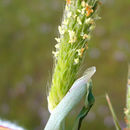en
names in breadcrumbs


Alopecurus, or foxtail grass, is a common and widespread genus of plants in the grass family. It is common across temperate and subtropical parts of Eurasia, northern Africa, and the Americas, as well as naturalized in Australia and on various islands.[6]
Foxtails can be annual or perennial. They grow in tufts. They have flat leaves and blunt ligules (a small flap at the junction of leaf and stem). Their inflorescence is a dense panicle (a branching head without terminal flower) with 1-flowered spikelets. A few, particularly A. myosuroides, are considered weeds, others are very decorative and are used in bouquets of dried flowers.
Numerous species once considered part of Alopecurus but now regarded as better suited to other genera: Agrostis Chaetopogon Cornucopiae Crypsis Koeleria Milium Muhlenbergia Pennisetum Perotis Phleum Polypogon Rostraria Setaria Tribolium
 meadow foxtail
meadow foxtail Alopecurus, or foxtail grass, is a common and widespread genus of plants in the grass family. It is common across temperate and subtropical parts of Eurasia, northern Africa, and the Americas, as well as naturalized in Australia and on various islands.
Foxtails can be annual or perennial. They grow in tufts. They have flat leaves and blunt ligules (a small flap at the junction of leaf and stem). Their inflorescence is a dense panicle (a branching head without terminal flower) with 1-flowered spikelets. A few, particularly A. myosuroides, are considered weeds, others are very decorative and are used in bouquets of dried flowers.
Species Alopecurus aequalis – Orange foxtail, shortawn foxtail – Eurasia, Americas Alopecurus albovii – Caucasus Alopecurus anatolicus – eastern Turkey Alopecurus apiatus – Kyrgyzstan, Tajikistan, Afghanistan, Iraq, Iran Alopecurus arundinaceus – Reed foxtail, creeping foxtail, creeping meadow foxtail – Eurasia, North Africa Alopecurus aucheri – Caucasus, Turkey, Iran Alopecurus baptarrhenius – Ethiopia Alopecurus bonariensis – Argentina, Uruguay Alopecurus borii – Turkmenistan Alopecurus bornmuelleri – Palestine Alopecurus brachystachus – Russia, China, Mongolia Alopecurus bulbosus – Bulbous foxtail – Mediterranean, western Europe Alopecurus carolinianus – tufted meadow foxtail – US, western Canada Alopecurus creticus – Greece, Turkey, Balkans Alopecurus dasyanthus – Caucasus, Iran Alopecurus davisii – Samos Island in Greece Alopecurus geniculatus – Bent foxtail, marsh meadow foxtail – Algeria, Eurasia Alopecurus gerardii – Mediterranean Alopecurus glacialis – Caucasus, Turkey, Iran, Afghanistan Alopecurus × haussknechtianus – central + northwestern Europe Alopecurus heliochloides – Chile Alopecurus himalaicus – Himalayas, Pakistan, Afghanistan, Iran, Central Asia, Xinjiang Alopecurus hitchcockii – Peru, Bolivia, Jujuy Alopecurus japonicus – China, Japan, Korea Alopecurus laguroides – Caucasus, Turkey Alopecurus lanatus – Turkey Alopecurus longiaristatus – Heilongjiang, Primorye, Khabarovsk Alopecurus magellanicus – northern Eurasia, North + South America, Falkland Is, South Georgia Alopecurus × marssonii – Ukraine Alopecurus mucronatus – Iran, Afghanistan, Tajikistan Alopecurus myosuroides – Slender meadow foxtail, black grass, twitch grass, black twitch – Eurasia, North Africa Alopecurus nepalensis – Himalayas, Tajikistan, Turkmenistan Alopecurus × plettkei – France, Germany, Belgium, Netherlands Alopecurus ponticus – Caucasus Alopecurus pratensis – meadow foxtail – Eurasia from Azores to Mongolia Alopecurus rendlei – central + southern Europe, Algeria, Libya, Turkey Alopecurus saccatus – Pacific foxtail – United States (WA OR ID CA), Baja California Alopecurus setarioides – France, Greece, Italy, Balkans, Turkey Alopecurus textilis – Turkey, Caucasus, Syria, Iraq, Iran, Turkmenistan Alopecurus turczaninovii – Siberia Alopecurus × turicensis – France, Switzerland Alopecurus utriculatus – Greece, Turkey, Iraq, Iran, Cyprus, Syria, Lebanon, Palestine Alopecurus vaginatus – Crimea, Caucasus, Turkey, Middle East, Iran, Afghanistan Alopecurus × winklerianus – France, Switzerland, Germany, Poland formerly includedNumerous species once considered part of Alopecurus but now regarded as better suited to other genera: Agrostis Chaetopogon Cornucopiae Crypsis Koeleria Milium Muhlenbergia Pennisetum Perotis Phleum Polypogon Rostraria Setaria Tribolium